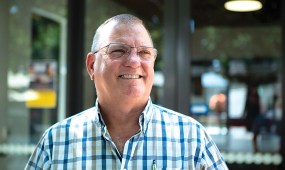
Mabel was born in the Riverland, the second eldest daughter of 15 children born to the late Anzac Walker and Linda Marie Giles.
From an early age it was obvious Mabel was a hard worker as she diligently performed household duties and looked after her younger siblings.
A sickly child, she caught shingles when she was 10 and was in an out of hospital, including for a major operation on her stomach. She was told she would never be able to have children. This was the start of Mabel defying all the odds.
Advertisement
She was a gifted child, an extremely quick learner and even more quick witted, having a come-back for everything and the gift of the gab, which served her well later in life.
Her father was a talented musician, playing guitar, steel guitar and the piano accordion, all of which he patiently and lovingly taught Mabel, who was quietly understood to be his favourite.
Mabel excelled as a musician, entertaining people from the age of 8 to 80, never disappointing.
Mabel was raised in a unique family that moved around from town to town, and lived on missions at Gerard, Raukkan and Narungga. This immersed the family in a rich diversity of Aboriginal cultures and established a connection between many Aboriginal nations.
A common thought was that Anzac was trying to avoid the authorities from taking his children away. As one of the stolen generation, he didn’t want the same ill fate for his beloved little ones.
It was in this vein that Mabel first became acquainted with the Andamooka opal fields and her love for small opal mining towns. Anzac was one of the first Aboriginal men from Narungga to be issued a mining permit in Andamooka.
Mabel moved to Adelaide from Narungga to work at Philips Electrical, staying with the Agius family, and she met her husband-to-be, Polish immigrant Bogdan Lochowiak. At the age of 19 she and Bogdan were married at the St Theresa Church in Walkerville in 1960.
After moving to various places, Bogdan landed a job at the Almond Farm in Tea Tree Gully where the couple started a family but tragically their first born, Robert, passed away at a very young age. This was a time of great trauma but soon John was born and life was good.
Mabel’s father was killed in a car accident when she was in her early 20s. He was the rock of the family and all were devastated. Mabel and Charlotte were called upon to help their grieving mother, Linda, to care for her large family. Once she recovered, Mabel and Bogdan were living in the Riverland when, after several miscarriages, they welcomed their first daughter Lynette who was born premature and was rushed to Adelaide for care.
Advertisement
Once Lynette was strong enough, the family decided to go north to Andamooka, where Bogdan began opal mining, and not long after they had their second daughter Leanne.
The young family then moved to Coober Pedy, where Mabel found her life passion of caring for the local Aboriginal Umoona community.
Once again looking after ‘the little ones’, she began working at the Coober Pedy Area School, in the Aboriginal education department.
Mabel set up one of the first Aboriginal education rooms where students would come in the mornings to be given clean clothes, often a uniform, and breakfast. After school the children would return to their original clothes, which had been washed, and were given a meal and help with their homework.
Mabel provided this service with love, kindness and compassion and taught them to be proud of their culture and traditions.
Witnessing Aboriginal children’s family issues at school, Mabel wanted to help further and started working for the Department of Children’s Welfare where her warrior like traits became apparent as she advocated fiercely for families.
The positive outcomes achieved led her to be elected as the chair of the Umoona Community Council, making her arguably the first female in SA, if not Australia, to chair an Indigenous council.
In this role over many years, Mabel established Aboriginal childcare, kindy, health and aged care services. She replaced many tin sheds on the Umoona Reserve with suitable housing and provided a holistic quality of service for Coober Pedy’s Aboriginal community.
Mabel served relentlessly on many boards and committees, including Aboriginal Legal Rights Movement, National Aboriginal and Torres Strait Islander Corporation, Aboriginal Health Council of SA, Country Health SA, the Courts Authority and Aboriginal Drug and Alcohol Council.
But her heart was with the many local Aboriginal organisations which entrusted her to represent them at state and national levels.
Her priorities shifted once she learnt of her sister Sharon’s leukemia diagnosis and she moved back to Adelaide, which also gave her the opportunity to be closer to her own children and grandchildren.
She was the donor for three stem cell transplants for Sharon and provided much-needed blood to her and other leukemia patients. She never did anything half-heartedly, and always with grace, dignity, rhythm and timing.
Mabel always knew how to act, what to say and had the right words at the right time, not just in profound wisdom; she could put the most colourful swear words into a phrase that sounded like poetry.
She was a great storyteller, comedian, entertainer, musician and singer – and always the life of the party.
A devoted worshipper at St Martin de Porres Chapel at Stepney, where her funeral Mass was celebrated by Fr James McEvoy, Mabel was a long-time member and supporter of the Aboriginal Catholic Ministry’s Otherway Centre.
Her son John, chair of the National Aboriginal and Torres Strait Islander Catholic Council, said Mabel was proud of her Catholic faith which was a big part of her life, including when she lived on Point Pierce Mission and her father would make the family walk to Maitland to attend a Catholic Mass.
Taken from the eulogy by Mabel’s nephew Michael Sostaric.






